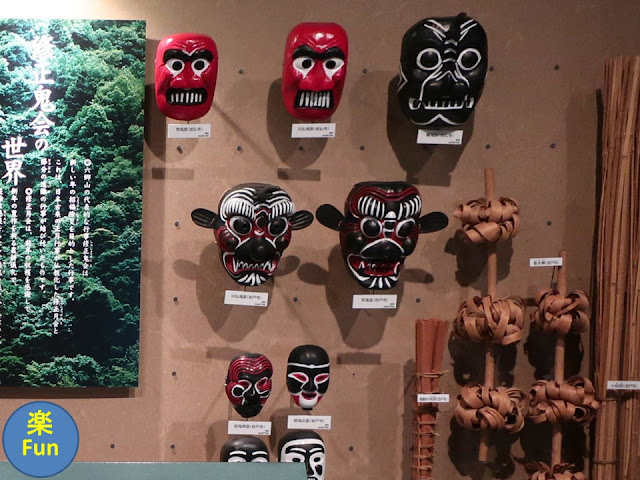Culture of Rokugosan、六郷山の文化
In the ancient, a mountain worship (Buddhism) initiated in Kunisaki Peninsula and many temples were built. It is Rokugosan.
国東半島では、古代に六郷山(ろくごうさん)という山岳仏教が始まり、以来多くの寺院が建てられました。
There are many stone works in Kunisaki; many of them were built in the medieval era when Buddhism spread among people; we always have something to pray.
国東半島には国東塔をはじめ、多くの石造物があります。仏教が民衆に広がった中世には多く作られました。常に人々の願いがあります。国東塔(複製)は写真左です。
A mountain training “Mine-iri” began in order to reconstruct the Rokugomanzan (mountain worship) in the Edo period (1603~1868). It was cut off one time, but was restarted in 1959.
近世には、低迷した六郷山復興のために「峯入り」(山岳修行)が始まりました。幕末に途絶えたのですが、1959年に再興されました。様々な形で祈り続けています。大分には高山はないのですが、岩山が多いようです。
What do you think what those masks are used for? There are two big torches beside the showcase. Those masks were used at Rokugosan ceremony called “Oni-e”. People thank gods for the harvest and pray for the good crops of the next year at the ceremony. The Oni (powerful beings) are expected to introduce a luck.
何の仮面だと思いますか? 仮面の両脇には大松明が置かれています。六郷山寺院の修正(しゅうじょう)鬼会(おにえ)の仮面です。前年の収穫に感謝し、新年の豊作を祈る農耕儀礼です。ここでは、鬼たちは福を招くと考えられています。
Those masks look like Southeast Asian ones, don’t they?
このお面はアジアっぽくないですか。
The photo above is a dance of Oni. In Iwato Temple, the ceremony starts at 3 PM. At 11 PM, monks sprinkle rice and worshippers pick up them, then, Oni dance. Oni go out and visit houses near the temple. Oni are treated, and return to the temple at 4 AM. The monks give mochi cakes to Oni and calm down them. That’s the end of the enthusiastic ceremony “Oni-e”.
鬼の舞(天念寺)。岩戸寺では午後3時の読経から始まります。11時に僧が米を撒き参拝者が拾う「米華(まいけ)」、鬼の舞、0時過ぎに鬼は寺を出て地区の家々を周り、接待を受けます。午前4時に寺に戻り、鬼を鎮めるための餅をくわえさせて、鬼会は終わります。熱くて盛り上がる行事です。
People entertain Oni at their house. 地区の家での接待(岩戸寺)
Reference: Kunisaki - Where Oni and Buddhas Coexist as One. (including a movie)
参考(日本遺産『鬼が仏になった里「くにさき」』、動画もあります):https://www.city.bungotakada.oita.jp/page/page_04211.html
The Widening Influence of Buddhist Culture、広がる仏教文化
Magaibutu (Buddha figure carved on a rock face) and so on are introduced.
磨崖文化などが紹介されています。
Faith and Lifestyle、信仰とくらし
Those are gods and Buddhas which people pray for. People consider mountains and seas as holy places which lead to the other world. And, there were shamans and fortune tellers in a village who could contact with gods or Buddha.
人々が祈りを捧げる身近な神仏。山や海などは他界とつながる聖なる場所と考えられ、また、村や町には占いや呪(まじな)い、お祓いを行う人々がいて神仏と頻繁に接触していました。
The statue on the right is a replica of a mountain god in Takeda City. It says, “Big wings, widened eyes and bared tooth are very weird. A mountain was respected as a place where gods were, so people created such a shape”. Two statues on the left are Sainokami (god) in Bungo City. Those are a symbol of a good couple and a prosperity of descendants. Those are really familiar gods.
右端は竹田市で祀られていた山の神像(複製)です。「大きな羽根、見開いた目、むき出した歯などとても奇怪な姿です。山は神々が居る場所としておそれ敬われていました。そうした気持ちが、このような山の神を生み出したのでしょう」と書かれていました。
左側の二体は夫婦和合と子孫繁栄を願うサイノ神(陰陽石、豊後高田市)です。まさに、身近な祈りですね。
A pilgrimage has been one of the most enjoyable events; the popular destinations have been eighty-eight temples in Shikoku Island and thirty-three temples in western Japan. Besides them, people have pilgrimed in the prefecture.
The notebooks on the left are stamp-books (Go-shuin-chou); red ink stamps were collected when people visited temples and shrines. It is very popular even until now. The coat on the right was used during a pilgrimage to the thirty-three temples in western Japan. Red ink stamps of temples are sealed on it. It is old and dirty, however people respected a pilgrim in a well-worn coat.
人々は四国八十八カ所や西国三十三ヵ所の巡礼に出かけるだけでなく、それらにならった県内の霊場にも出かけました。今も人気の御朱印帳(左)だけでなく、巡礼の帷子(右)も展示されていました。使い込んでいる方が値打ちがあるようです。
A visually impaired monk visited houses, and prayed for the family or did fortune-telling with playing a biwa guitar. For example, they purified the site before the construction of the new house. There were forty to fifty visually impaired monks in the Edo period (1603~1868).
We are losing chances to pray.
国東では、琵琶を弾いて祈祷や占いをする盲僧が家々を訪れ、地鎮祭などを行ったそうです。江戸時代には、四五十人いましたが、今はいません。
祈ることが減っていますね。
Festivals and events、まつりと行事
Various festivals in the prefecture are listed on the panel. The target, the bow and the arrows are displayed which are used in the festival to predict the crop situation.
県内のさまざまな祭礼行事が紹介されています。歩射(ぶしゃ)祭の弓矢と的などが展示されていました。
Festivals of people、日々のまつり
People have various family festivals. It says, “These days are different from ordinal days, it is called ‘Fine days’. In such days, people take holidays, dedicate to worship the gods. Wearing the fine clothes in fine feeling and eating fine cuisines, they come in contact with the gods. People get new vitalities through these festivals.” Performing family festivals which mainly thank to the ancestors would give a good influence to children.
家々で行うまつりです。仕事を休み、ハレの日の着物を着て料理を食べ神仏と交わります。「このことによって、人々はまた明日からの活力を得るのです」と書かれています。家の行事を大切にするということは、教育上も良いことかもしれません。
Our lives、人の一生
Religious events are introduced in the section. The particular one is “Jizou-nagashi” (flowing Jizo Bodhisattva) which is a memorial service for marine casualties. People chant and hit a gong, and flow Jizou-nagashi-tags toward the sea during Higan season (around Spring Equinox Day).
盆の精霊船など全国的に行われている行事とともに、海難者を供養するために、春の彼岸に行う地蔵流しという行事も展示されています。鉦を鳴らし、念仏を唱えながら地蔵流し札を海に流します。県南の海岸部で行われます。
The palace lantern surprised me. The sceneries of temples, mountains and so on are expressed in the luxurious lantern. People bring it to the grave yard on the final day of the Bon season and burn it.
びっくりしたのが「御殿灯籠」です。宇佐市長洲で作られる幅2mぐらいの豪華な灯籠で、寺院や山、川、月などの情景が表されています。なんと、精霊送りの日に墓地まで担いでいって燃やします。
Daily life of people、日々のいとなみ
There are many sorts of prayers in the daily life of people. People pray every day and everywhere in a house such as not only in an altar but also in a kitchen stove and even in a toilet.
日々のいとなみの中にも祈りがあります。「台所のカマドや便所にいたるまで、人々は神仏がいるものとして日々祈っていたのです」と書かれています。日本人らしいですね。
The replica hall of Fukiji Temple, which is one of Rokugosan Temples, is set at the center of the exhibition room. The interior is as colorful as the one when it was built.
展示室の中央には、六郷山寺院の富貴寺(ふきじ)大堂(おおどう)が彩色鮮やかに再現されています。
There are ancient tombs at the museum site.
博物館の外は、古墳がある宇佐風土記の丘です。
Visited in May, 2022
Official website: Virtual museum: https://oita-rekihaku.jp/ (You can choose English version)
https://www.pref.oita.jp/site/rekishihakubutsukan/ (in Japanese), accessed in
October, 2022
Previous post
(religious culture in this prefecture): Oita Prefectural Museum of History(1/2)、大分県立歴史博物館 part 1
Next post (museum in the same prefecture): Kitsuki castle town museum、きつき城下町資料館





















Comments
Post a Comment